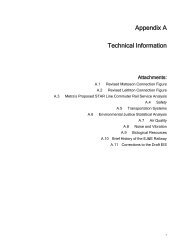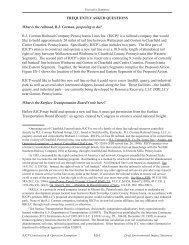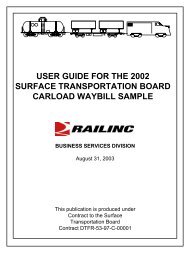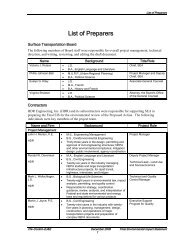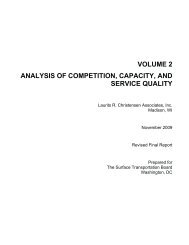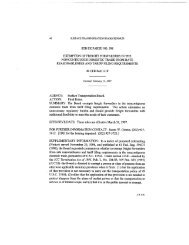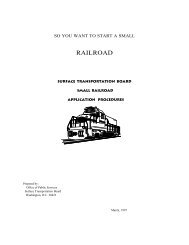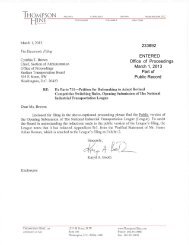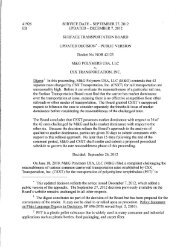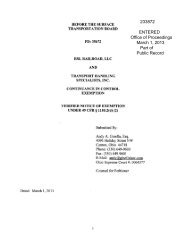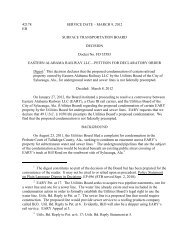Norfolk Southern/Conrail Rail ConnectionâBucyrus, Ohio - Surface ...
Norfolk Southern/Conrail Rail ConnectionâBucyrus, Ohio - Surface ...
Norfolk Southern/Conrail Rail ConnectionâBucyrus, Ohio - Surface ...
Create successful ePaper yourself
Turn your PDF publications into a flip-book with our unique Google optimized e-Paper software.
STB Finance Docket No. 33388<br />
National Wetlands Inventory Maps<br />
NWI maps show various water features with a focus on wetland resources. The inventory was<br />
completed by USFWS through a stereoscopic analysis of high altitude aerial photography and<br />
delimitation of wetland types on USGS topos. Wetlands are classified by USFWS in accordance with<br />
Classification of Wetlands and Deepwater Habitats of the United States. A particular wetland is<br />
located and classified in detail on NWI maps by a sequence of alphabetical and numerical symbols<br />
based on the attributes of the wetland. A comprehensive explanation of the classification system is<br />
provided in the map legend. This classification system includes a broad range of the types and extent<br />
of wetland resources, as well as other water features. However, for this evaluation, wetlands were<br />
identified as rivers, lacustrine (reservoirs, lakes) or palustrine (any vegetated wetland). Palustrine<br />
wetlands were further identified as forested, shrub/scrub, or emergent (containing herbaceous<br />
vegetation) wetlands. There are often differences between the USFWS definition of a “wetlands” and<br />
the definitions of various federal, state, and local regulatory agencies. All NWI wetlands that occur<br />
within 500 feet of the proposed construction are depicted on figures.<br />
Soil Survey Maps<br />
Soil surveys have been completed by NRCS for a large number of counties in the United States. Maps<br />
have been prepared for each survey that show the types and extent of soil types. A subset of the soils<br />
mapped by NRCS is classified as “hydric;” that is, soils subjected to prolonged periods of flooding,<br />
ponding or saturation. The occurrence of a hydric soil provides an indication that an area may be a<br />
wetland. Information from the soil survey maps was used to cross-reference other sources of<br />
information to better understand the soils and hydrologic conditions at select locations.<br />
Site Visits<br />
The proposed construction site was inspected and reviewed in the field by environmental scientists.<br />
Information about surface water resources and other areas of interest was collected during the<br />
inspections. Field notes and photographs taken during the inspections were retained for later review and<br />
utilized to amend and refine information derived from other sources.<br />
Evaluation Criteria<br />
The following criteria were used to assess the potential impacts to surface water resources and wetlands<br />
that could result from the proposed construction project:<br />
• Alteration of creek embankments with rip-rap, concrete, and other bank stabilization measures.<br />
• Temporary or permanent loss of surface water area associated with the incidental deposition of<br />
fill.<br />
• Downstream sediment deposition or water turbidity due to fill activities, dredging, and/or soil<br />
erosion from upland construction site areas.<br />
• Direct or indirect destruction and/or degradation of aquatic, wetland, and riparian<br />
vegetation/habitat.<br />
• Degradation of water quality through sediment loading or chemical/petroleum spills.<br />
• Alteration of water flow that could increase bank erosion or flooding, uproot or destroy<br />
vegetation, or affect fish and wildlife habitats.<br />
The extent and duration of impacts to surface water resources and wetlands resulting from the project<br />
would depend primarily on the type of work to be completed and the size of the project. The overall<br />
effect could be lessened by avoiding important resources and minimizing impacts to the extent<br />
practicable, and by implementing the mitigation measures. Prior to initiating construction, regulatory<br />
agencies would be consulted regarding the need to obtain permits, such as U.S. Army Corps of<br />
Engineers’ (COE) Section 404 permits, National Pollution Discharge Elimination System (NPDES)<br />
permits, and state-required permits or agreements, as appropriate.<br />
BIOLOGICAL RESOURCES<br />
Information regarding biological resources potentially occurring at, or in the immediate vicinity, of the<br />
proposed project (within 500 feet of the center line) was collected from a variety of sources, including<br />
USGS topographic maps, NRCS soil survey maps, lists of threatened and endangered species, reference<br />
books on regional flora and fauna, and information databases. In addition, federal and state agencies<br />
D-17




